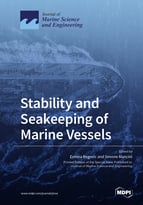Stability and Seakeeping of Marine Vessels
A special issue of Journal of Marine Science and Engineering (ISSN 2077-1312). This special issue belongs to the section "Ocean Engineering".
Deadline for manuscript submissions: closed (10 June 2020) | Viewed by 36138
Special Issue Editors
Interests: naval architecture; seakeeping; high-speed craft; hydrodynamics; planing hull
Special Issues, Collections and Topics in MDPI journals
Interests: computational fluid dynamics (CFD) simulations; marine hydrodynamics; ship design; ship seakeeping and maneuverability; verification and validation process
Special Issues, Collections and Topics in MDPI journals
Special Issue Information
Dear Colleagues,
Stability has always been the first safety issue for any marine vessel, and static stability evaluation has been adequate for ship service. Recently, research interests have focused on ship dynamics and stability failure modes in rough seas for higher safety. Seakeeping assessment today is one of the most important design features to establish operational limits for both speed and comfort.
The purpose of the invited Special Issue is to publish the most exciting research with respect to the above subjects, to provide a rapid turn-around time regarding reviewing and publishing, and to disseminate the articles freely for research, teaching, and reference purposes.
High-quality papers are encouraged for publication, directly related to various aspects, as mentioned below. Novel techniques for the study are also encouraged.
Some of the topics included in stability and seakeeping of marine vessels are:
- Ship stability;
- Seakeeping;
- 2nd-generation intact stability criteria;
- Ship dynamics;
- CFD, EFD, time domain simulations;
- Direct assessment.
Prof. Ermina Begovic
Dr. Simone Mancini
Guest Editors
Manuscript Submission Information
Manuscripts should be submitted online at www.mdpi.com by registering and logging in to this website. Once you are registered, click here to go to the submission form. Manuscripts can be submitted until the deadline. All submissions that pass pre-check are peer-reviewed. Accepted papers will be published continuously in the journal (as soon as accepted) and will be listed together on the special issue website. Research articles, review articles as well as short communications are invited. For planned papers, a title and short abstract (about 100 words) can be sent to the Editorial Office for announcement on this website.
Submitted manuscripts should not have been published previously, nor be under consideration for publication elsewhere (except conference proceedings papers). All manuscripts are thoroughly refereed through a single-blind peer-review process. A guide for authors and other relevant information for submission of manuscripts is available on the Instructions for Authors page. Journal of Marine Science and Engineering is an international peer-reviewed open access monthly journal published by MDPI.
Please visit the Instructions for Authors page before submitting a manuscript. The Article Processing Charge (APC) for publication in this open access journal is 2600 CHF (Swiss Francs). Submitted papers should be well formatted and use good English. Authors may use MDPI's English editing service prior to publication or during author revisions.
Keywords
- Ship stability
- Seakeeping
- 2nd-generation intact stability criteria
- Ship dynamics
- CFD
- EFD
- Time domain simulations
- Direct assessment







